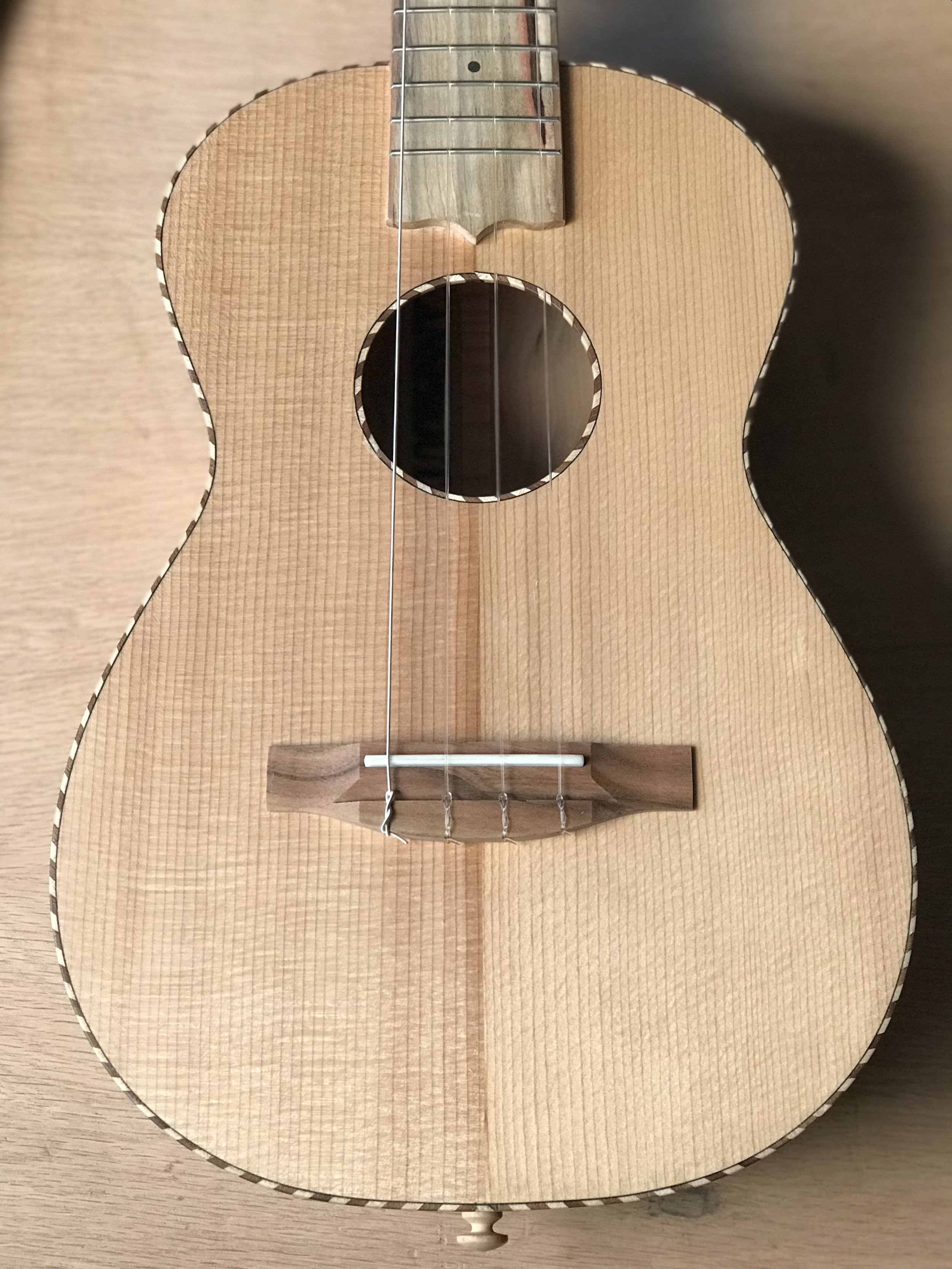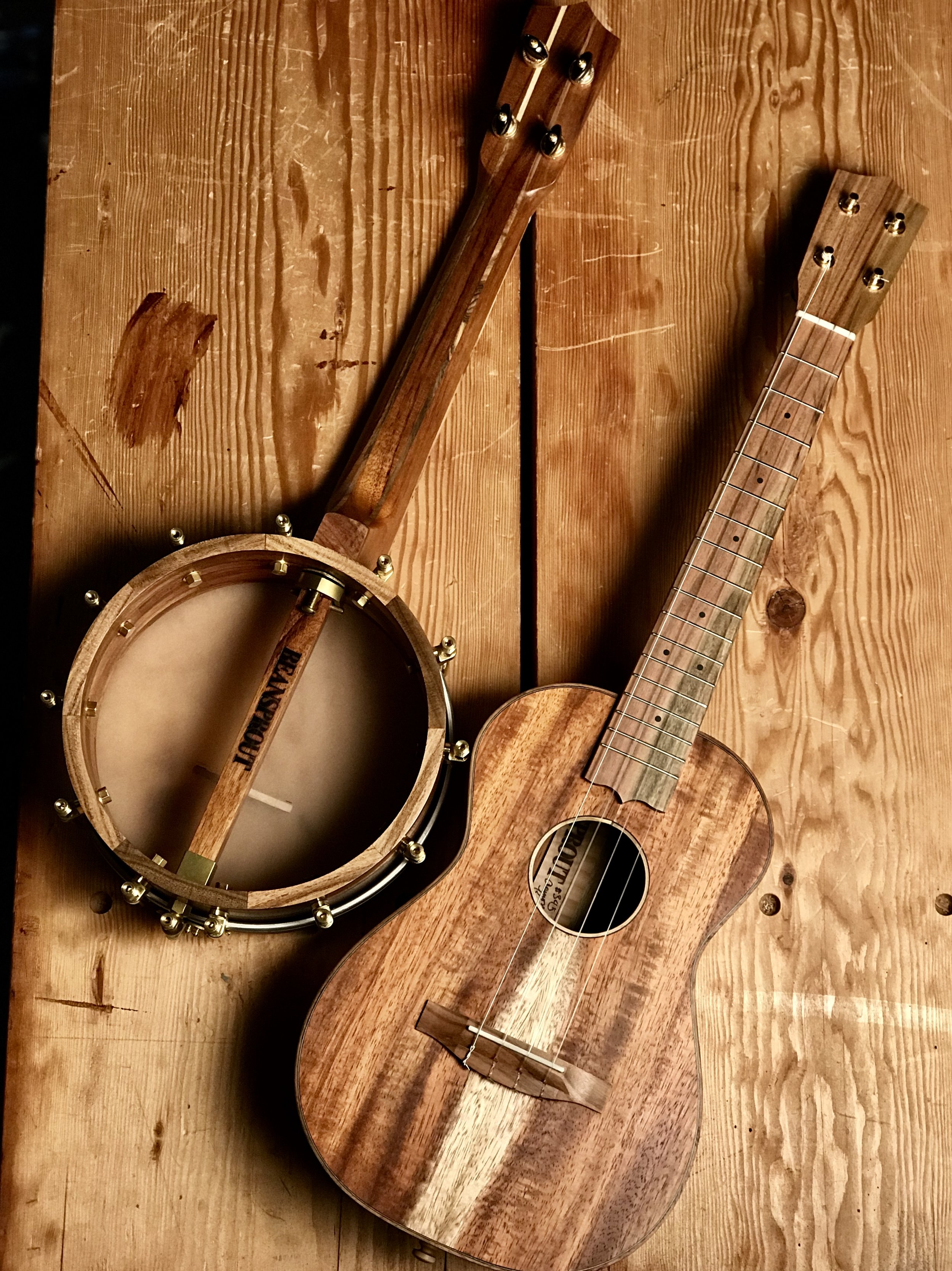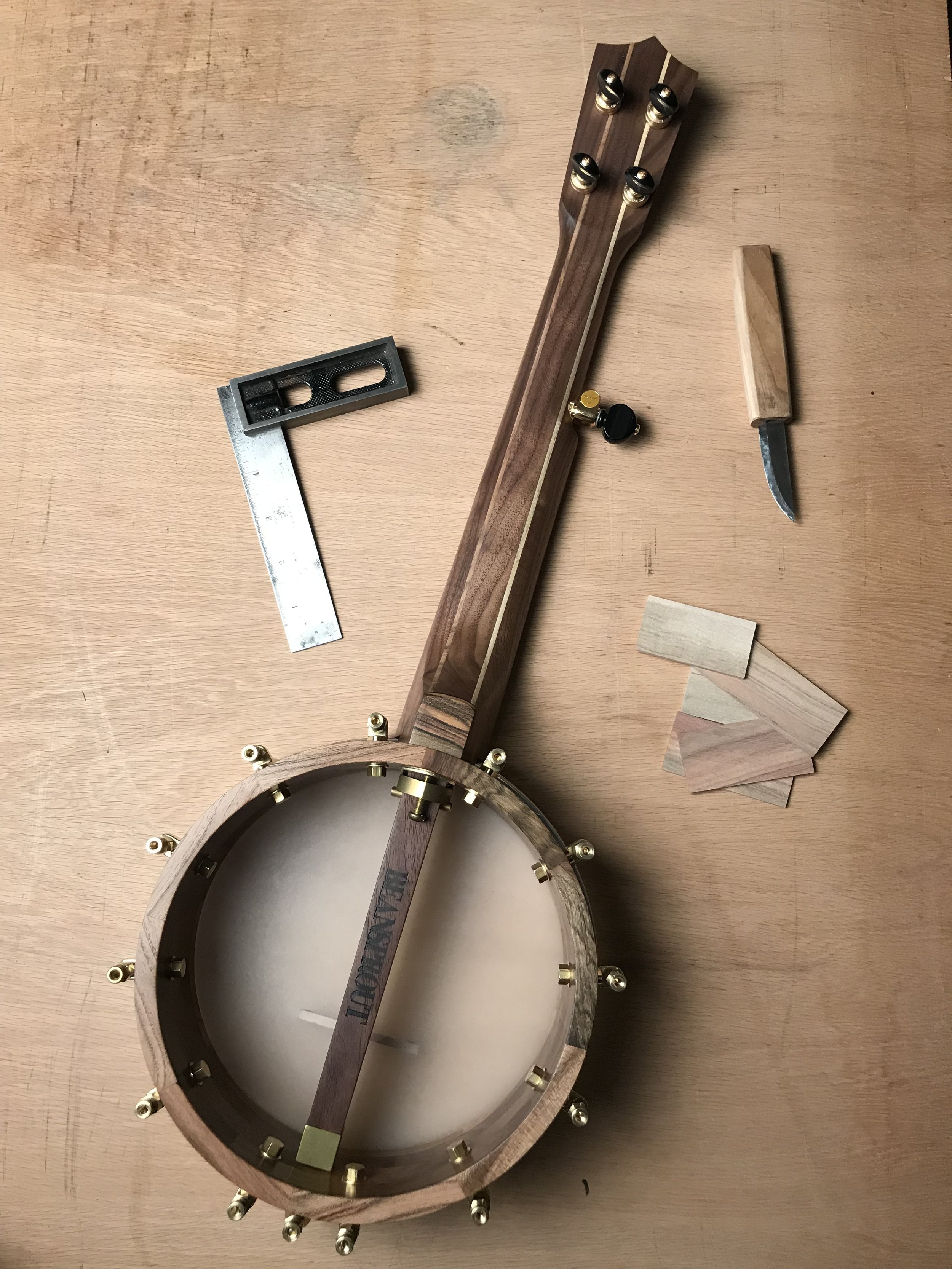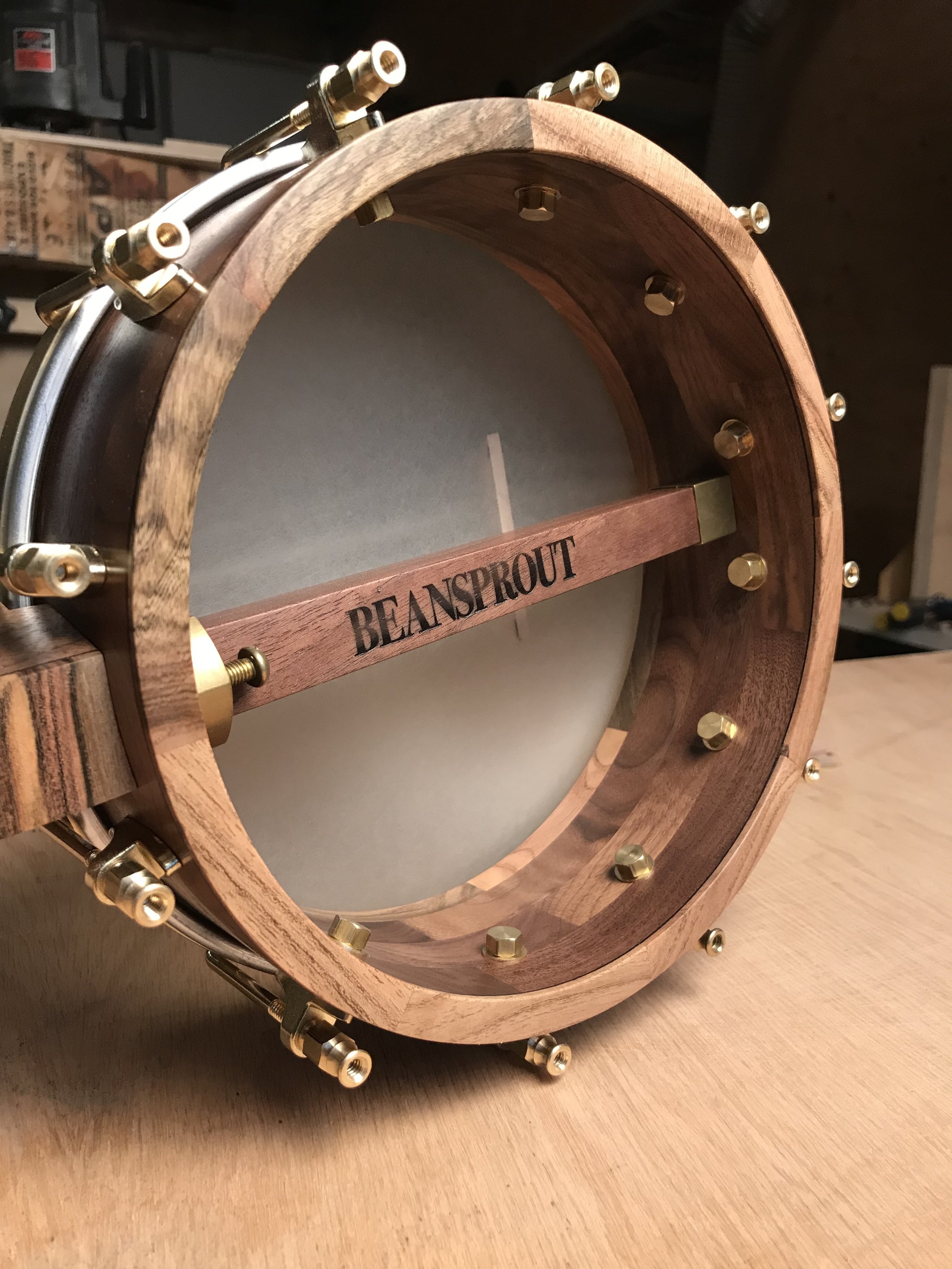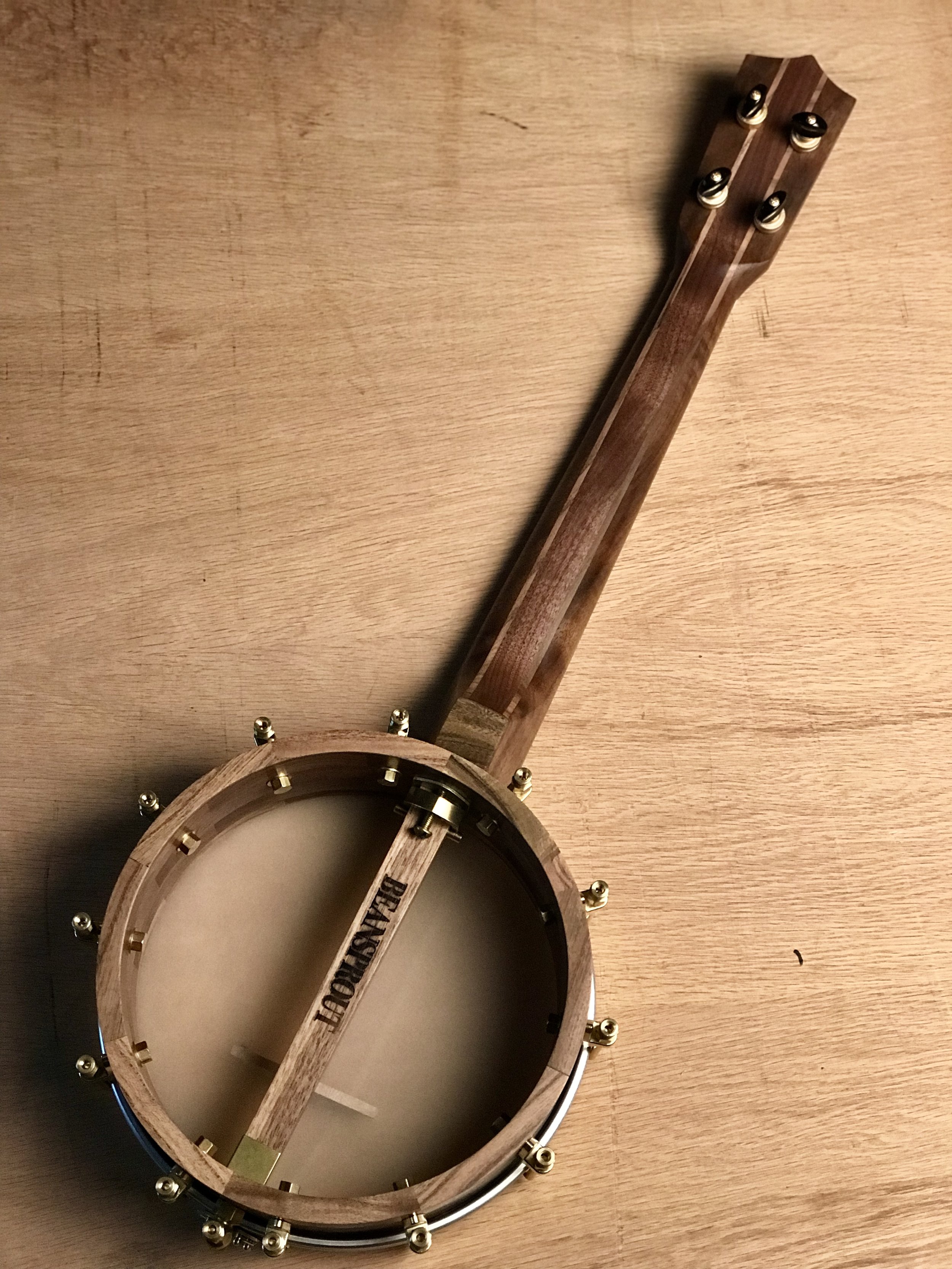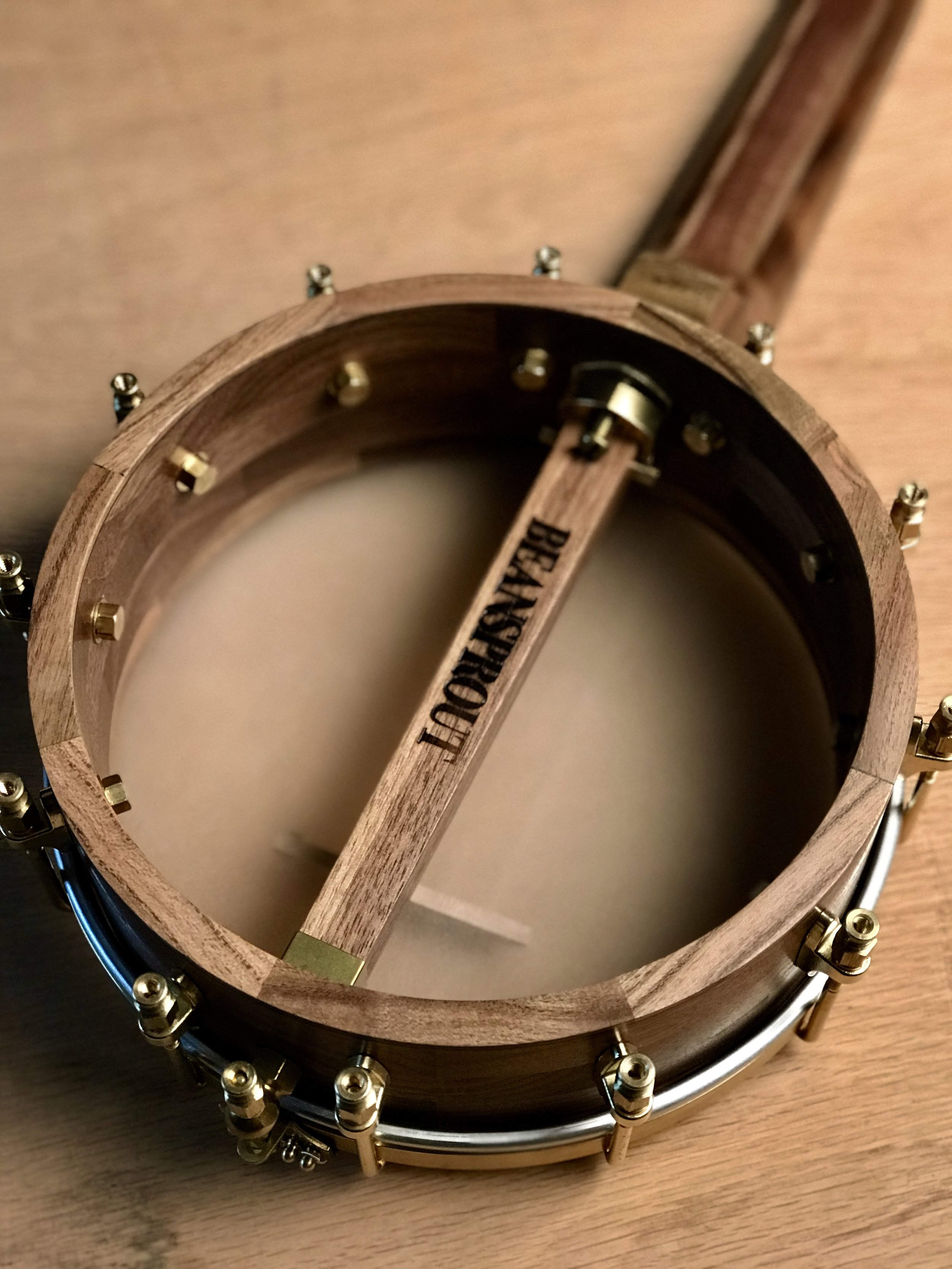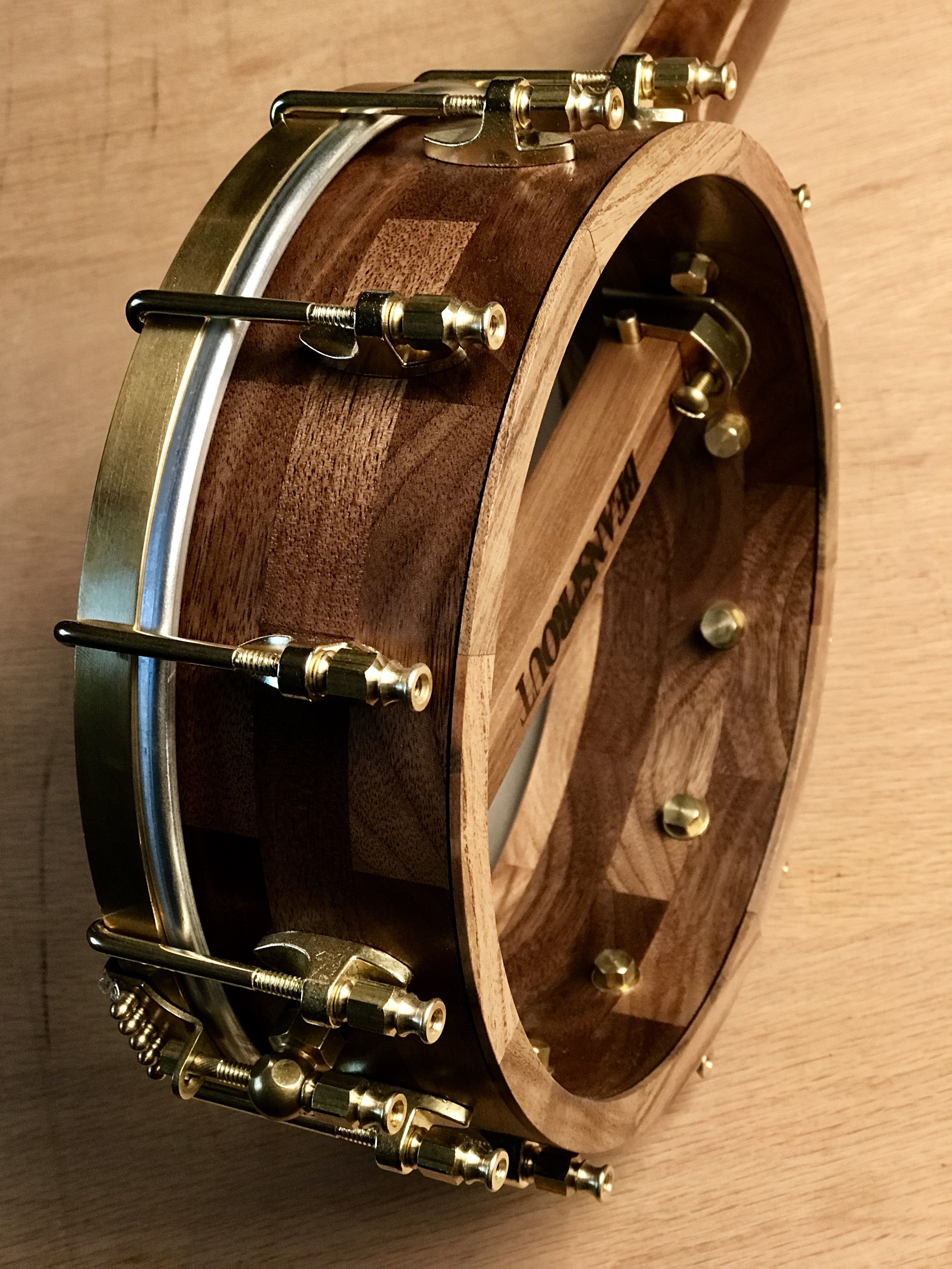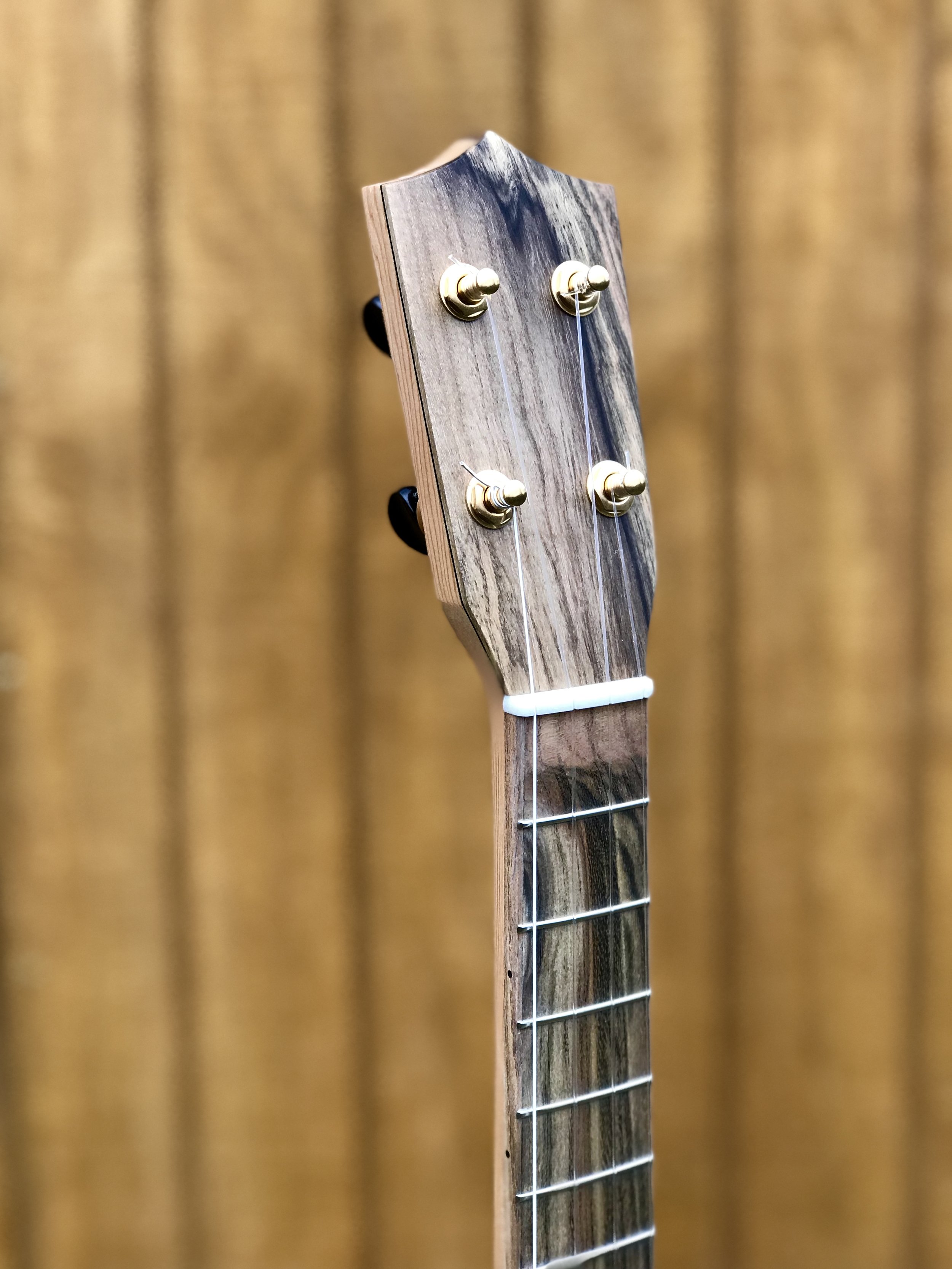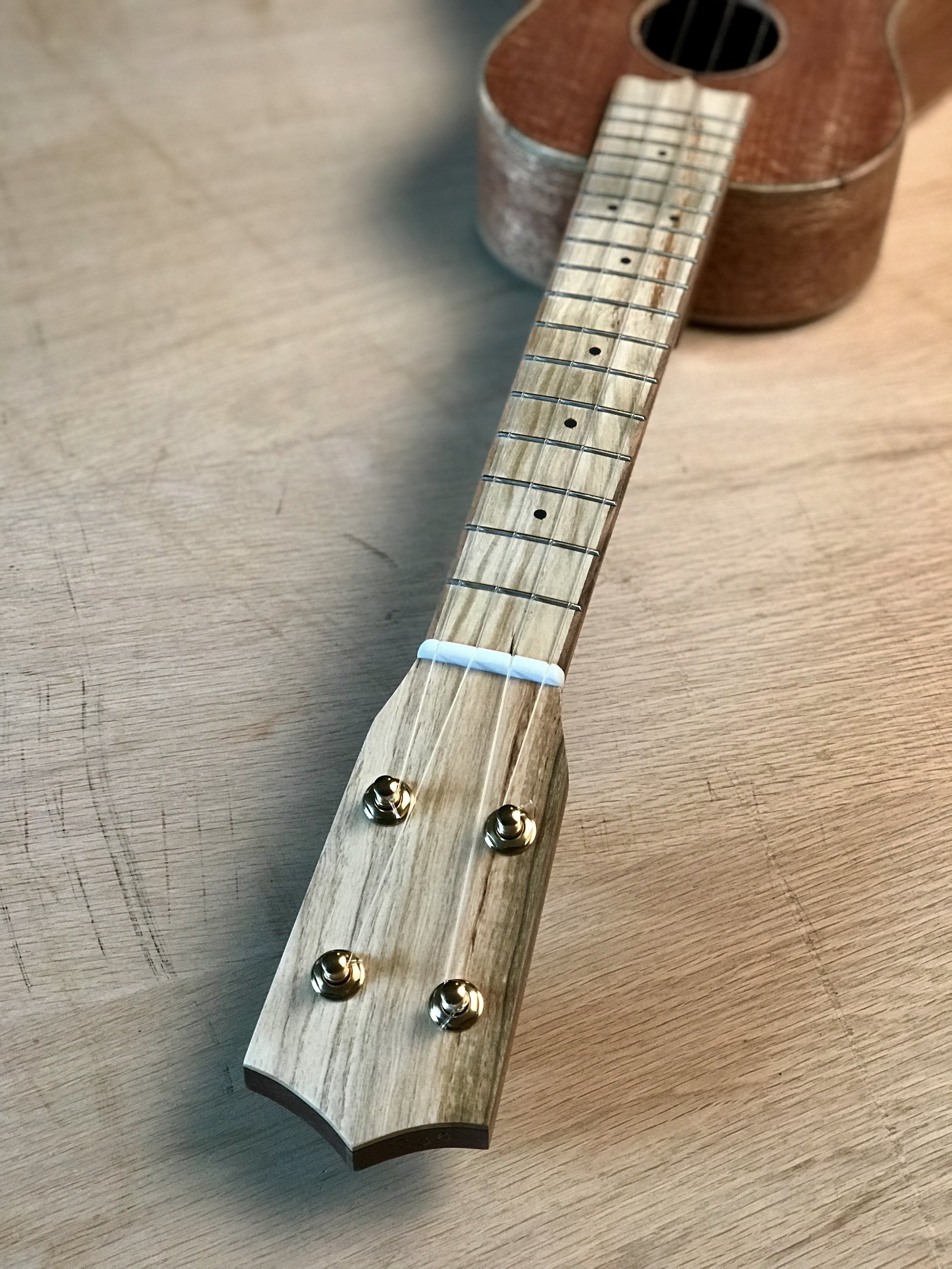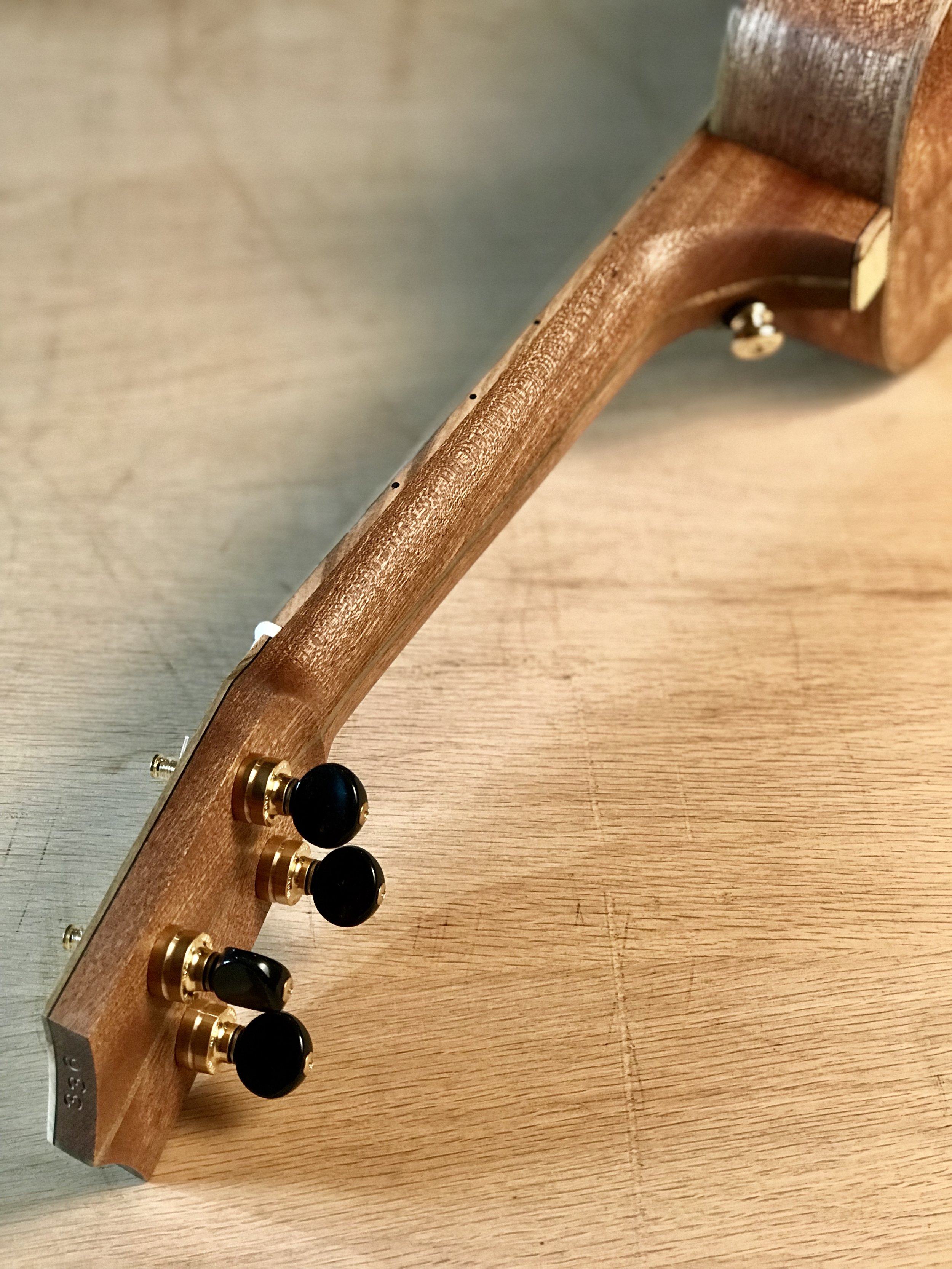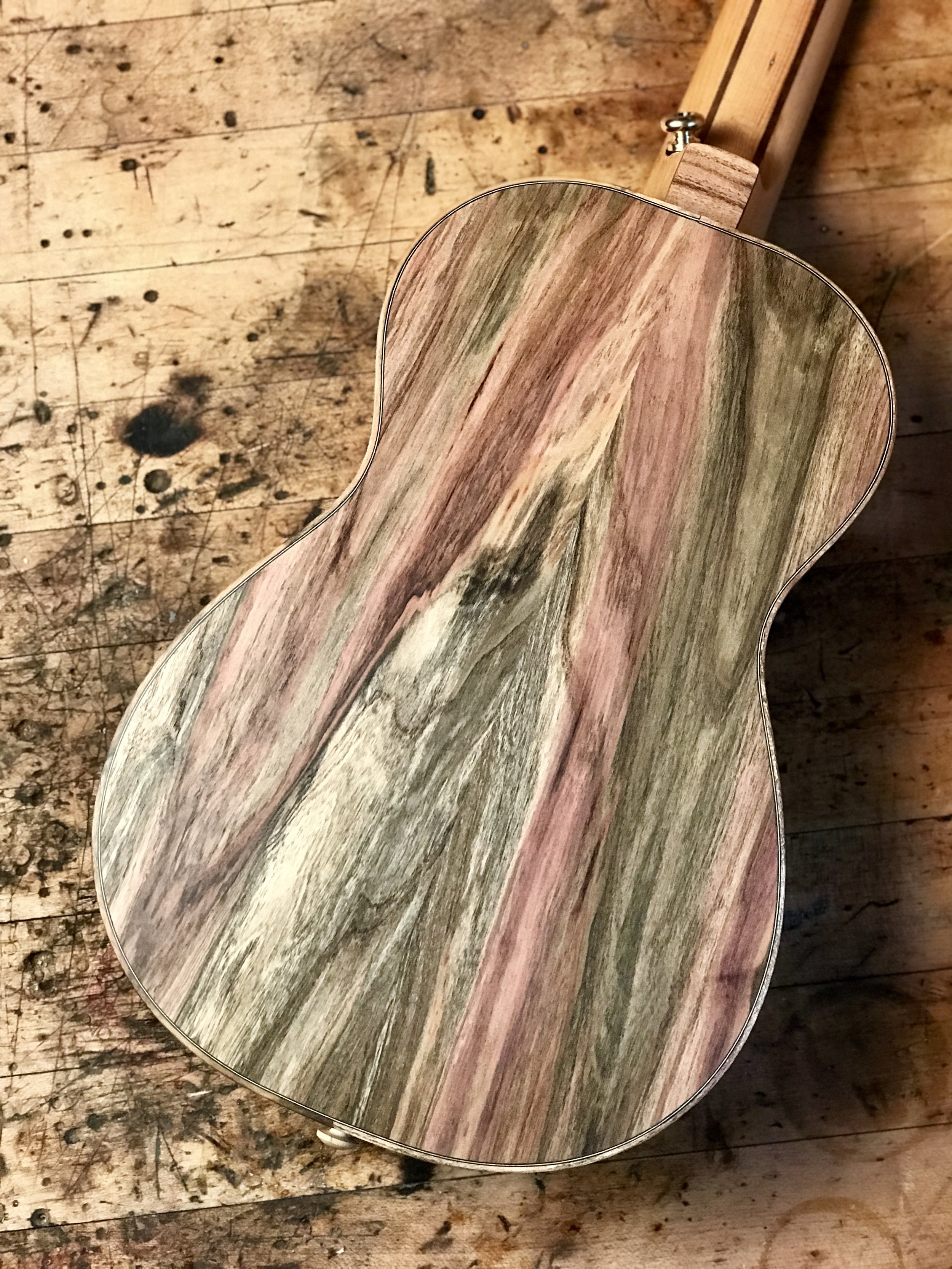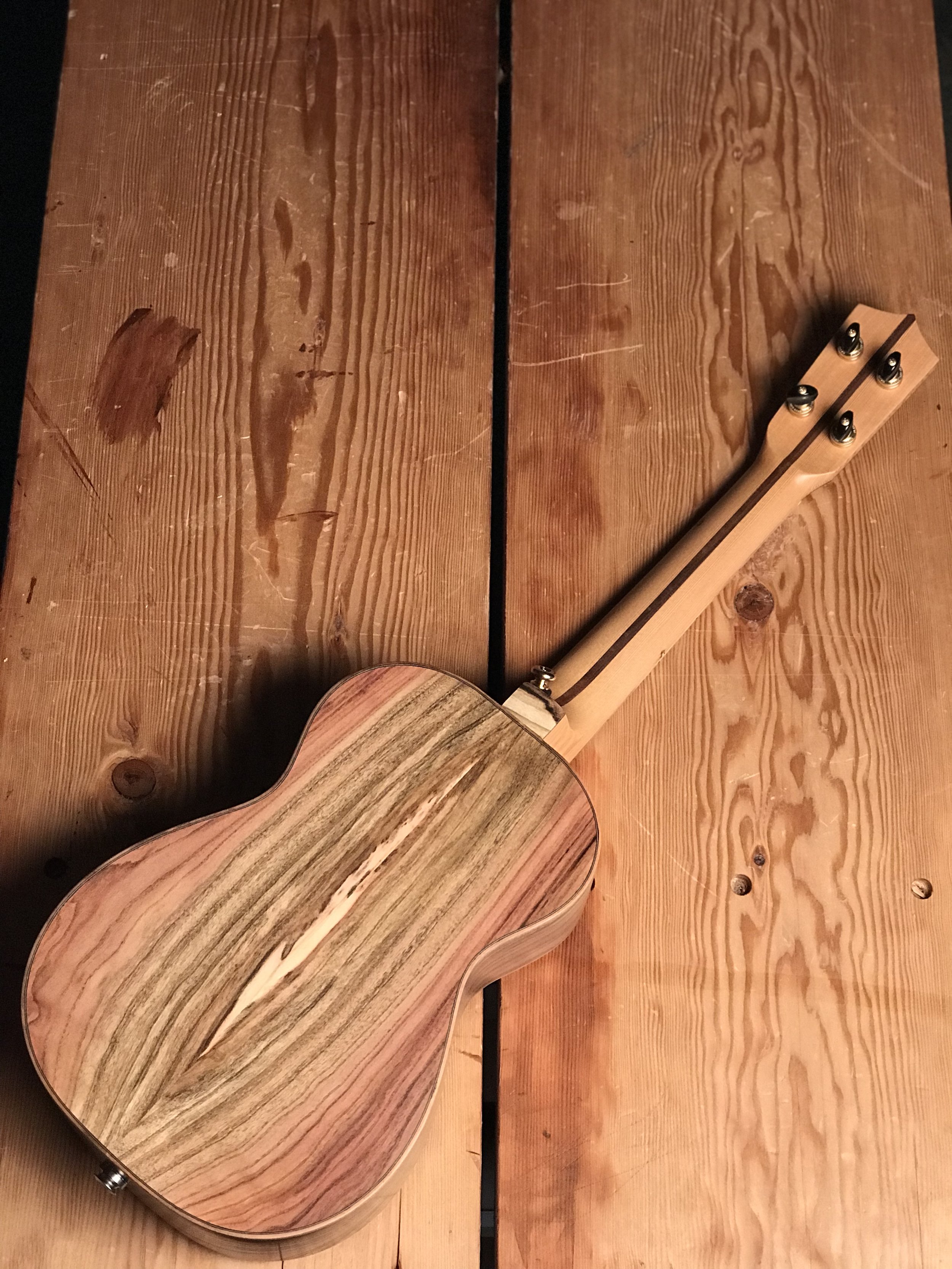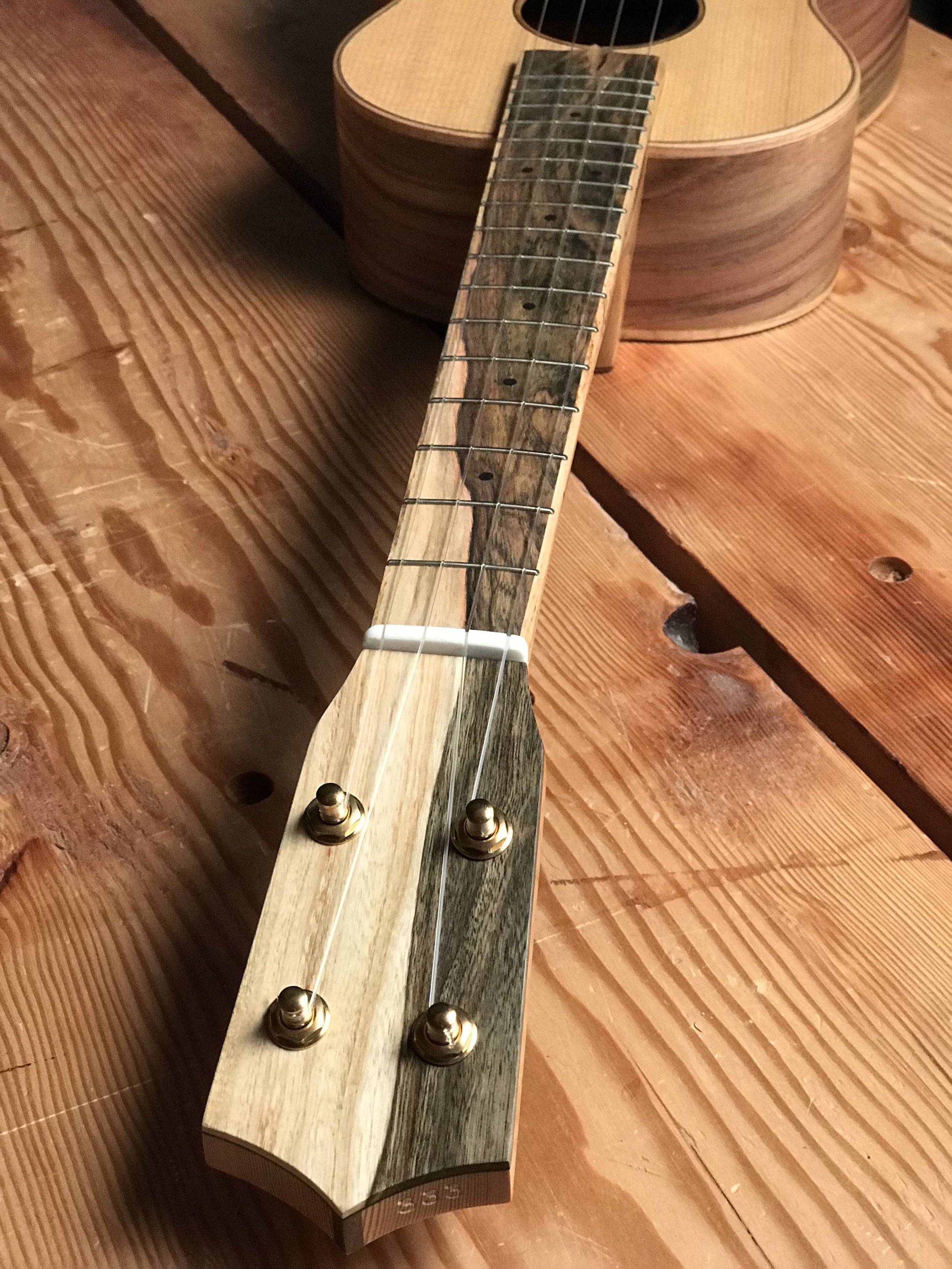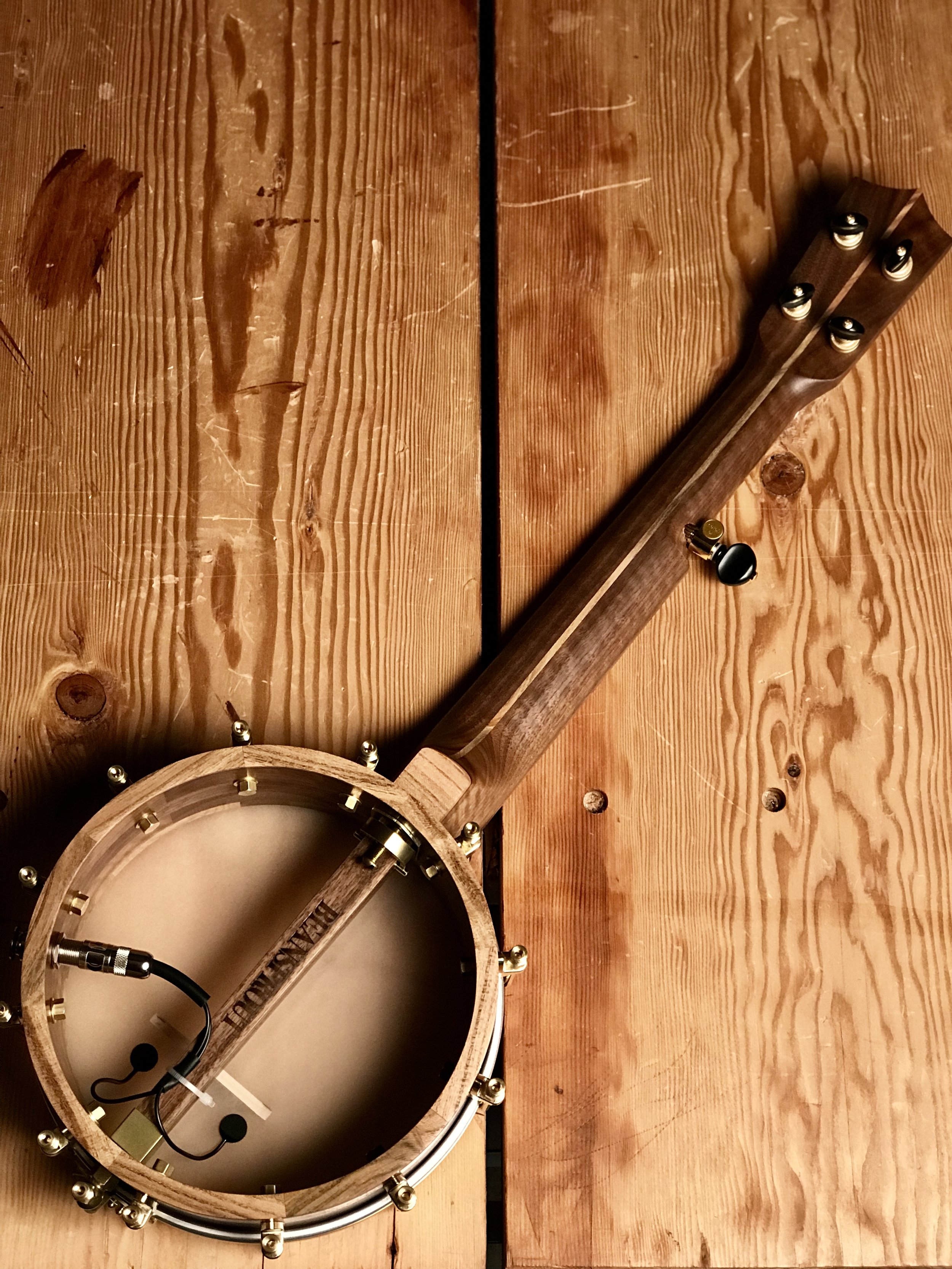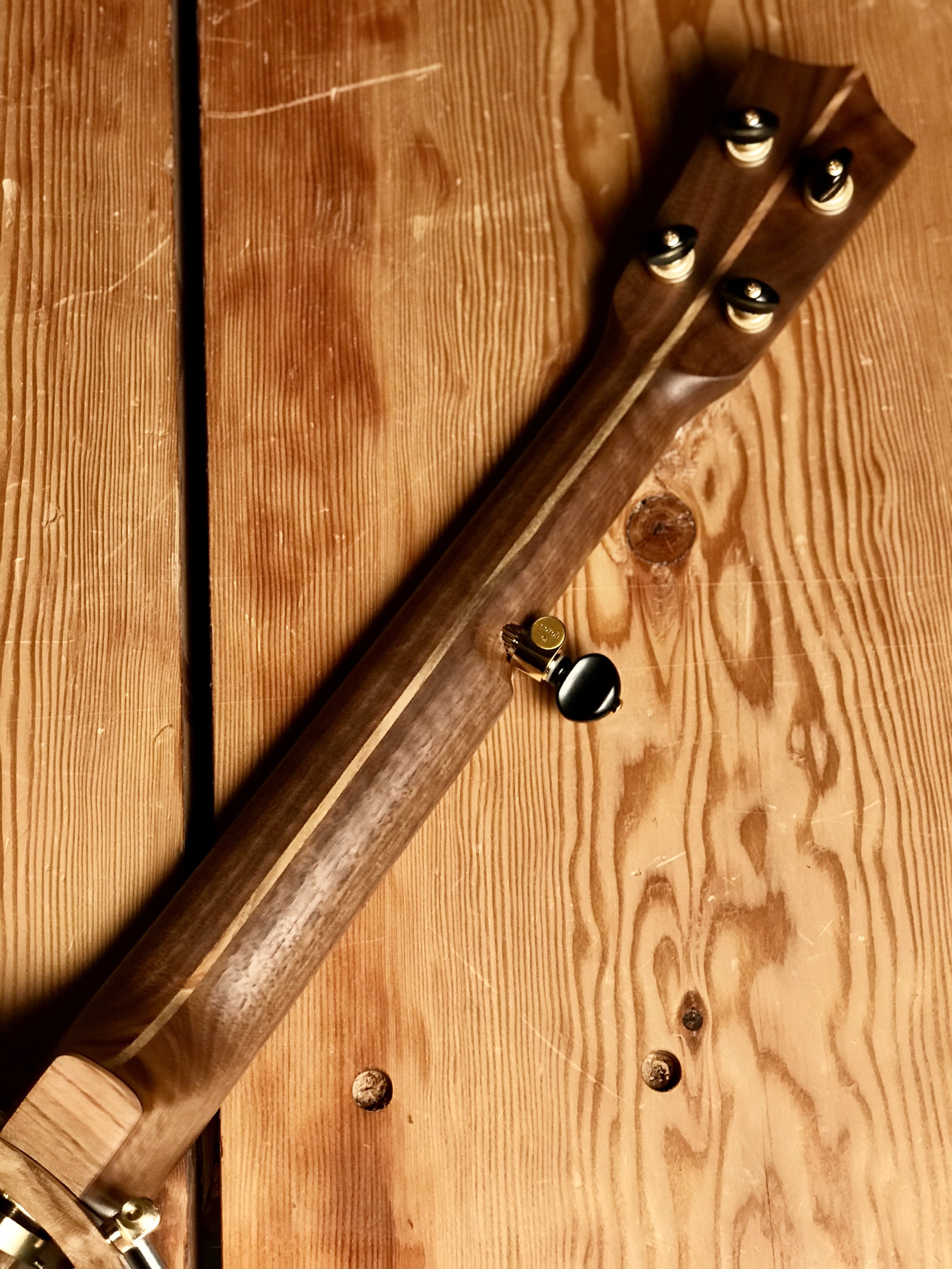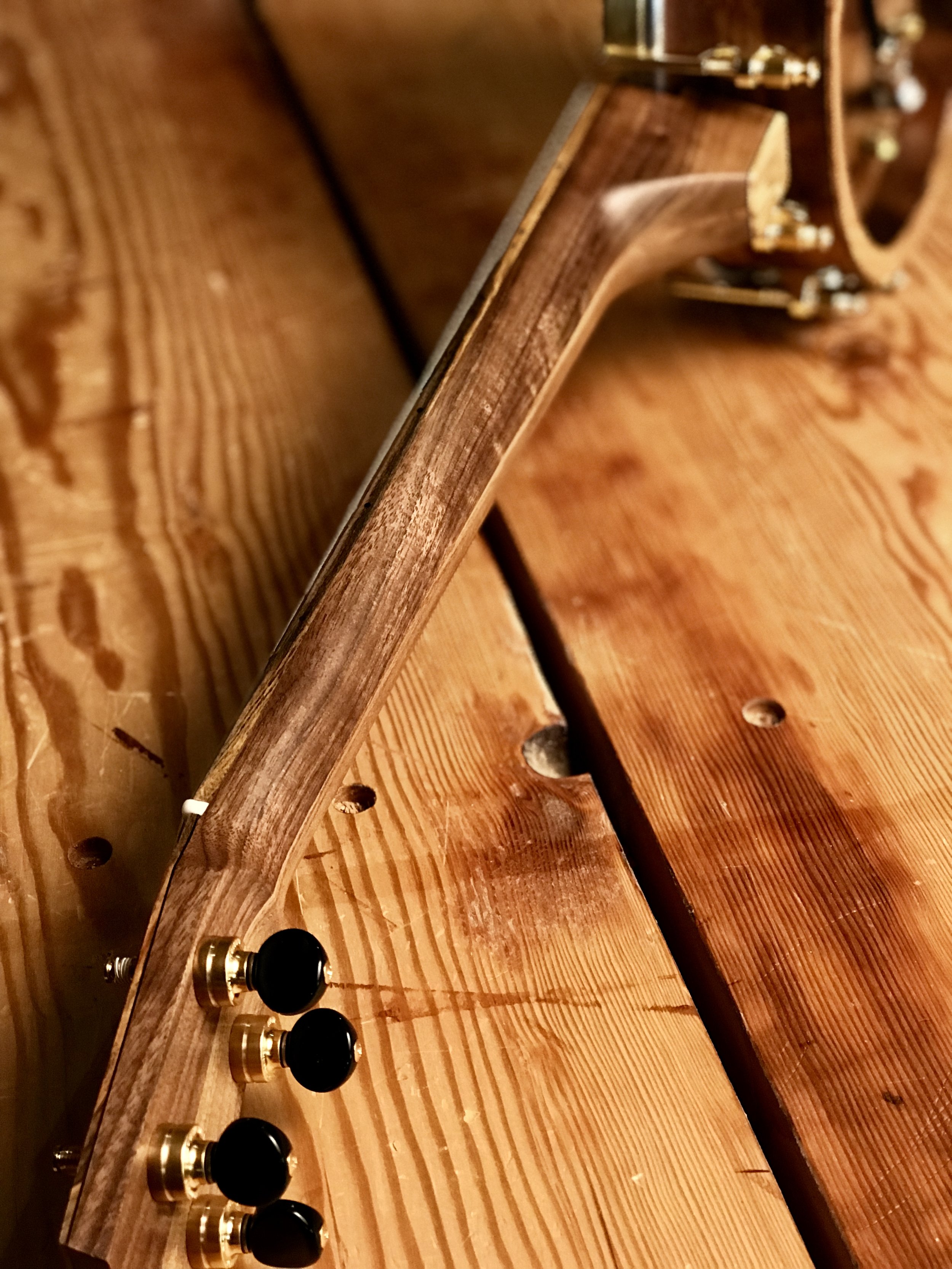One of the best parts of making stock instruments to my own specs is that I get to choose woods that might be over looked by customers. These cherry back and sides are a great example of a figured hardwood that is readily available, looks beautiful and sounds great. Also, I could pick some “orphaned” slices of spruce for the top and a fretboard that needed a bit of extra work because of a natural bark inclusion. This one looks unique, sounds fantastic and fits within my ecological/economic values for wood use. Win. The spruce is old growth Sitka that my friend Steve got me from a dulcimer builder. The neck is Hemlock from a salvaged floor joist, the cherry back and sides are from Char from Mya-Moe and the pistachio is from California Orchards.
#348 Master Grade Myrtle Tenor Ukulele
This is a special board of myrtle that came from another customer. It came to me as partial trade for her instrument and I was happy to be able to get another instrument or two from it. She bought it for a furniture project that never happened, now it gets to be an ukulele! When the top is this interesting, picking the other parts can be pretty challenging. In this case, I played it safe and left everything else straight grain and stripey. The fir neck comes from my friend’s property on Vashon Island, complete with bug holes. The pistachio comes from California Orchards.
#346- Curly Port Orford Cedar, Figured Walnut, Fir and Pistachio Alto Ukulele
This one really illuminates what I want Beansprout to be/do:
-Woods: All North American wood, from people I trust or salvaged from local sources. The curly Port Orford Cedar, pistachio and figured walnut come from the Oregon and California, provided by woodfromthewest.com. The fir is salvaged from factory floorboards in The Dalles, OR. The walnut and maple rope binding is made by Gurian in Seattle.
-Design: The alto size and shape is my attempt to provide an all purpose small size uke. Cute and traditional like a soprano, but a little bigger for adults to play comfortably. This simple template interacts with some asymmetrical and sculptural wood choices to make a unique but classic look
-Sound and playability: Loud but rich, with the charm of a vintage small ukulele. Easy to play all the way up the neck. Easy to keep in tune with geared tuners and ready to plug in onstage.
-Art vs Craft- Handmade with rustic details and unique wood “flaws/inclusions” but with careful craftsmanship and attention to detail. A beautiful thing that is also a useful tool.
Sorry for the mini manifesto, back to the shop.
#353 Walnut and Pistachio Tenor Banjo Ukulele
I often wonder what our business would look like if we didn’t have the internet to supply us with customers. In this case, James is a local, so his experience might give a little insight. To begin with, this instrument was bartered for, which is hard to do long distance. Also, he came over to the shop and picked out wood, which can’t happen with every customer. Lastly, if it ever needs repair or adjustment, he can just drop by instead of having to ship it. But, if I only built banjo ukes for locals, I have a feeling I wouldn’t get to build as many!
This lightly curly walnut is urban salvage from Goby in Portland. The beautiful green/gray/brown pistachio is from California Orchards.
#349- Clockmaker's Koa Concert Banjo Uke
A banjo uke made from Koa? Why not. The koa is from the Carpenter Ant Stash, from a pile of boards that Lizann’s grandfather made clocks from. The pistachio is from California Orchards. It’s going to Stephen, who has a wonderful connection with the date this uke was finished!
#345 Clockmaker's Koa Tenor Ukulele
Sometimes, it is easy to get distracted by the many paths (and woods) we have before us. When that happens, I feel good about falling back on the tried and true, the classic designs. My four year old son Henry defines classic as “old but good” and I think he is right. In this case, a koa tenor ukulele with a mahogany neck. Super classic. I added the pistachio fretboard, headplate and trim to make it my own, but it falls squarely in line with the long tradition of Hawaiian craftsman that I sit at the feet of. Go play it, Doug, you are a true classic who deserves a classic uke.
The koa come from the Carpenter Ant stash, from the boards that Lizann’s grandfather made clocks from. The Pistachio is from California Orchards. The mahogany is salvaged from a fireplace mantle.
#343- Bear Claw Spruce and Master Grade Myrtle Tenor Ukulele
Lately I have been drawn to the muted tones and matching colors/textures of the Wabi-Sabi aesthetic, but for this design I was interested in exploring more visual contrasts. The old growth bear claw spruce top from Alaska Specialty Woods has a vibrant look and sound. The dynamic pistachio fretboard introduces red and green elements. The master grade myrtle back and sides from the Oregon coast (provided by woodfromthewest.com) brings a vibrant sound and whimsical texture that interacts with the green from the fretboard. The Douglas Fir neck is salvaged from floor boards and includes one nail hole to remind us of our flaws. A bit of this and a bit of that, but I love it just the same, wrapped up in rope binding.
Today we found out that poet Mary Oliver passed away, so I leave you with her words:
You do not have to be good.
You do not have to walk on your knees
for a hundred miles through the desert repenting.
You only have to let the soft animal of your body
love what it loves.
I love this uke and I love the people I made it for.
#350- Maple and Pistachio Tenor Banjo Ukulele
About 3 years ago, I went to a cabinet maker’s estate sale one town over. His shop was a one car garage and he had no dust collector! The entire place had 12” of wood shavings and scraps on the ground. In one corner, I found a pallet of maple strips cut to 1”x3”x24” and bought them all. I should have bought the oak pallet too! When I got them home, my son Henry had fun laying them out as a dance floor in the shop. He would put a bunch out while I worked and then we would put them away when we were done. Anything to keep a little one busy, right! Having these strips already milled lets me see the grain and figure easily and quickly process them into banjo parts. A real blessing. This tenor model with a low G is all Henry’s dance floor maple and pistachio from California orchards.
#351- Walnut and Pistachio Concert Banjo Ukulele
I’ve been working lately to try and unify the materials for these instruments a bit more. What I mean is, the rim, neck, fretboard, headplate, etc…all get processed at different times up to three months apart. That means I have to keep track of what is what for several months of instruments at a time. Not a big deal, but it takes time, space and lots of extra wood inventory to make sure everything matches well. In this month’s case, I also am trying to make the fretboards and headplates flow together in an organic way, which also takes extra work. I think its worth it, even if no one else notices it! Walnut from the Carpenter Ant stash, pistachio from California Orchards.
#344- Walnut and Pistachio Mini Five String Banjo
This banjo is a great example of our little global business and musical culture. To begin with, it is for a customer who lives a few hours away from us but we met in Alabama at a music camp. She used to live in Hawaii and we considered grabbing some Koa from her property for the instrument before choosing Oregon walnut and California pistachio instead. The banjo is an American instrument with clear origins in West Africa. This mini version is scaled down to ukulele size, an instrument that started in Portugal and flourished in Hawaii. It was made by a guy from Wisconsin who lives in Oregon and plays Appalachian music on Hawaiian and African instruments. That is one good thing about music and musicians, we like jumping over walls better than building them.
#339- Curly Port Orford Cedar and Pistachio Tenor Ukulele
It’s the end of 2018 and this is the last instrument to ship. Even after 10 years doing this, I still need to re-learn the lessons of my past over and over again as I progress. In education, we call this a spiral curriculum; revisiting a concept repeatedly but addressing it with new wisdom each time. In this case, the customer picked out his pistachio and cedar from woodfromthewest.com. I had a catastrophic accident when routing for binding that destroyed the back. You would think by now that this wouldn’t happen to me, but sometimes wood has a mind of its own and it doesn’t get along with rhe router. I had to scramble to pick a new back for the customer and get back on track. I heard Gordon in my head with a common lesson from my early days: “it’s better to do it right first than have to back up and do it twice.” Regardless, it was time to double down and deliver my best work, no matter what happened along the way.
In the end, I am pleased to deliver a tenor uke with good volume, rich tonality and a unique look. Made from materials I believe in with a minimum of environmental impact. Produced in my own space with hand tools and machines I have carefully collected. Destined for a musical life that I can never imagine. What a great way to spend a year.
#340- Walnut and Pistachio Five String Banjo
As a maker, I am in a constant dialogue with my customer, my present self, my ambitions for the future and my past decisions. This is most clear when building a second instrument for someone. In this case, Steve Varney, who plays as Kid Reverie and with Gregory Alan Isakov, needed a second banjo. I built the first in 2011 and it reflected my skill set and capabilities at the time. Since then, I have had it back for updates and repairs as Steve has traveled the world with Gregory. His input on what he needs and what works on the road has influenced this build, as well as my current values, knowledge and capabilities.
For the numbers people:
-11 3/4 walnut block rim with rolled brass tone ring. This was the first big rim I ever turned on my new lathe.
-Walnut neck with 25.5” scale, 20 frets on a pistachio fretboard.
-24 hooks with and nuts, with special SS Stewart style shoes from Brooks Masten. (He made the custom tension hoop and tone ring too.)
-Hawktail tailpiece from Balsam Banjo Works for extra downward pressure.
-Mini humbucker pickup, contained in a custom wooden block behind the dowel stick.
-Fiberskyn head, GHS strings, Gotoh tuners.
-Walnut from Goby and Pistachio from California orchards.
Many of these design decisions were outside my norm, but led me to new places. What feels special about this is Steve’s place on the stage in front of thousands of music fans. He connects me to this energy and I put more into it, realizing the stakes are higher. Of course, I want my couch strummers and weekend warriors to get my full attention when their instrument is on the bench, but this symbiosis with a touring pro radiates our to their build as well. The extra effort is worth it. If Steve feels better playing the banjo, Gregory feels better singing the song, the crowd has a better experience and some person’s heart is healed from the beautiful music. We road dogs and dust devils just keep trying every day, maybe tomorrow will be better because of it.
#342- Walnut and Pistachio Concert Banjo Ukulele
Since I started building banjos I have always tried to buy and stockpile the nicest maple I could afford. Maple is the most traditional banjo wood, so I figured I would always need it. Since I restarted Beansprout, folks have been picking walnut over maple 4 to 1! Luckily, there is plenty of walnut available in Oregon. This summer I went back to visit Ken and Lizann at the Carpenter Ant stash to grab some more walnut, but I had already cleaned all the walnut out of the shed! We went down to the basement shop and I found a shelf in the corner with cutoffs from years of Ken’s furniture projects. There were three boxes of chunks of Oregon walnut, too small for furniture but perfect for the little banjos I build. Each cutoff was from a different board and project, so every color and grain pattern was represented. This makes this current batch of banjo rims more interesting to look as well as ecologically and economically sound. Wrap it all up in Pistachio from California orchards and this one is ready for service.
#341- Walnut and Pistachio Tenor Banjo Ukulele
Sometimes I think of myself as a toolmaker more than a luthier. What I build is designed to do a job, a musical one of course. That musical work can be private or public, skilled or clumsy, for pay or not, but it serves to build up a community like any useful tool. Certain tools have reputations as well made, beautiful and useful, with those in the know coveting them and passing them down. The Delta Unisaw, the Willy’s Jeep, Stanley No 5 jack plane, Fender Telecaster, Zippo lighter, etc...
All of these have been updated and copied, but the basic design is classic and solid with a well earned reputation.
It seems the walnut tenor scale banjo uke is currently my most popular tool, sent all over the world to be useful and beautiful for any style of music by any sort of player. This one, like all it’s comrades, uses the same materials: Oregon walnut, California Pistachio and brass from North Carolina. If you look closer, it is unique of course, with its own special details, but still contained with in its (hopefully someday) classic form.
#338 - Sycamore, pistachio and fir tenor ukulele
Traditionally, ukuleles were made of all one wood for the top back and sides. On the islands, this was often Koa while mahogany was a good substitute on the mainland. To make this format work, you have to pick a medium density wood that is suitable for the top, back and sides. In this case, American Sycamore works great. It’s a traditional ukulele sound, but a unique look from an easily obtainable wood. I love how sycamore looks rather plain and classic from far away, but pretty psychedelic up close! In this case, the sycamore comes from The Carpenter Ant stash in Portland, the fir neck is salvaged from a pig farm in The Dalles, OR and the pistachio comes from California orchards.
#336- Mahogany Alto Ukulele
To me, the Japanese concept of Wabi-Sabi applies to my instruments in three ways. 1) Aesthetically: Muted natural colors, smooth but variable textures, a celebration of unique flaws and inclusions and a reverence for natural materials. 2) Philosophically: The idea that nothing is perfect. What makes you flawed is what makes you unique, beautiful and worthy of celebration. 3) Temporally: The idea that objects change over time with use and weathering of age. The evidence of its use is seen as beautiful.
The owner of this uke, Peter, told me he wanted mahogany and he liked Wabi-Sabi. He left the rest up to me. I chose an amazing set of figured mahogany with dozens of tiny bug holes from the Carpenter ant stash for the body, some straight grain mahogany for the neck and some simple, muted pistachio for the fretboard, binding and trim. But, viewing the instrument from 10 feet away is completely different than up close. When you zoom in, the mahogany grain pops, the book matched bug holes show up and the “plain” pistachio show off tiny variations and color changes. Most notably, there is a bug hole that grazes the lower bout in an amazing feat of wood boring. It wasn’t visible when I bent the sides, but showed up when sanding. I see it as a happy accident to celebrate and a reminder of the chaos of the world intruding on our daily work. We can embrace it or scream about it, it’s up to us.
#334- Port Orford Cedar and Pistachio Tenor Ukulele
A stringed instrument is really an interesting design problem. It has to be stout enough to stand up to string tension and player use/abuse, but light enough to vibrate freely and produce a good tone. I spend my days stripping layers of wood away in some places and building them up in others, with my experience and the knowledge of the masters before me guiding my way. (For more on the subject, click here). After bracing and voicing so many instruments over the years, you would think I would be over it, but it still is a thrill to string a new one up and hear its voice. Every day is new chance to get it right! And speaking of chances, this is the 4th (?) I’ve made for Louise in the last few years, I am grateful for the business and the relationship!
The port orford cedar top as a little spalting and mineral staining, which adds to its unique look. The pistachio back and sides, fretboard, headplate, binding and bridge come from California orchards. The old growth Douglas fir neck is salvaged from a burn pile and includes several filled bug holes.
#333- Spruce and Pistachio Tenor Ukulele
For my work, you may notice that I don’t really use the word “custom.” To me, custom means that the customer is closely involved with many design ideas and specifications, up to and including body shape, scale length as well as decorative details. What I do is more of like a small tasting menu at a Chef centered restaurant. You show up because you are excited about this Chef’s food, you make a few basic decisions and let the Chef decide the rest. This means that I turn away a lot of customers who want more than I am willing to do. But, every once in a while a customer has a few suggestions that I am happy to work on, as they align with my ideas or what I want to work on and improve.
In this case, Jeremy already had a few ukes I worked on at Mya-Moe and had real stage experience that led him to make a few simple suggestions. Jeremy lives in Mississippi and his ukes get quite a bit more exposure to humid air and sweat. The Tru-Oil finish that we used to use wasn’t holding up for him. I have many reasons that I don’t want to use a spray booth and associated finishes, so I had to find another wipe on finish that would hold up. From the recommendation of banjo builder Brooks Masten, I switched to a poly/oil mix and I like it a lot. I will wait to see if Jeremy thinks it wears better. Also, he was a good candidate for a thin, clear, plastic pick guard to be added to the top, further protecting it. The nice thing about these is that they can be removed easily in the future if need be.
The top for this uke is some old growth Sitka spruce that I inherited from a dulcimer builder. It is one long, thin piece cut and half and joined together. I love how it breaks the more common book matched look and highlights the shimmering grain from different directions. I also worked hard to line up the sap wood on the fretboard and headplate, which I am pleased with. The neck is made of salvaged Douglas Fir floorboards, complete with old nail holes. The Pistachio is harvested from California Orchards.
He gets a uke that fits his needs, I get to explore ideas to make all of my instruments better.
#337- Walnut and Pistachio Mini Five String Banjo
A couple of years ago I stood in a long line outside of a wood worker’s estate sale in Hood River. When it opened, everybody ran in and claimed their treasures. I grabbed a machinist’s tool box, a hand plane, some dado saw blades, an oil can and a chunk of walnut. This curly Oregon walnut was already rough cut in the shape of two rifle stocks. It just so happens that many banjo builders are also gun smiths. This is because both disciplines require you to work wood to the precision of the metal parts that must mate with them. Also, there is the obvious old timey American rural connections of guns and banjos. In fact, I don’t know anything about guns beyond learning to shoot in the Boy Scouts. So, here are two rifle stocks, re-purposed for a more peaceful pursuit. The pistachio is some deep red stripey stuff from California Orchards.
#335- Walnut and Pistachio Tenor Banjo Uke
This is just a solid example of what makes my little banjo ukes so nice. They can be loud or soft, sweet or rich, brassy or mellow, all depending on your touch and your imagination. From the beginning, the best compliment I’ve always gotten was: “It's a banjo uke, but it doesn’t sound sh##ty!” Truth.
Two color, slightly curly Oregon walnut from Goby. Pistachio from woodfromthewest.com. Ready for service.







